Iveco Daily van review (2024)
Tough, truck-like build and plenty of safety kit
PROS
- Long service intervals and warranty
- Great aftersales support
- Largest panel van on market
- Powerful engines, excellent eight-speed auto
- Alternative fuel choices
CONS
- Not the best for running costs
- Limited UK dealer network
- Interior quality could be better
- Tough build reduces 3.5t payload
- Not as good to drive as best rivals
Summary
The Iveco Daily takes a different approach to the majority of the best large vans. Instead of an all-in-one structure, it uses a separate chassis with a body bolted on top, just as it has done since it was first introduced in 1978. This makes it particularly strong, and ideal for very heavy payloads.
This engineering solution draws on Iveco's background as a truck manufacturer, and enables gross vehicle weight (GVW) ratings of up to 7.0 tonnes (7.2 tonnes for the chassis cab), far in excess of any other large van. And while payload for the 3.5-tonne model does lag behind rivals, due to the underlying truck-style engineering, there are now some options to make the vehicle lighter and get some carrying ability back.
We have a van weights explainer page, if it helps.
2024 model year update for the Iveco Daily
Now in its third-generation, this latest Daily was first launched in 2014. After a thorough update in 2019 it has continued to evolve and improve, with comfort the focus for the 2022 model year and now another significant overhaul for the 2024 model year (known as the MY24 Iveco Daily).
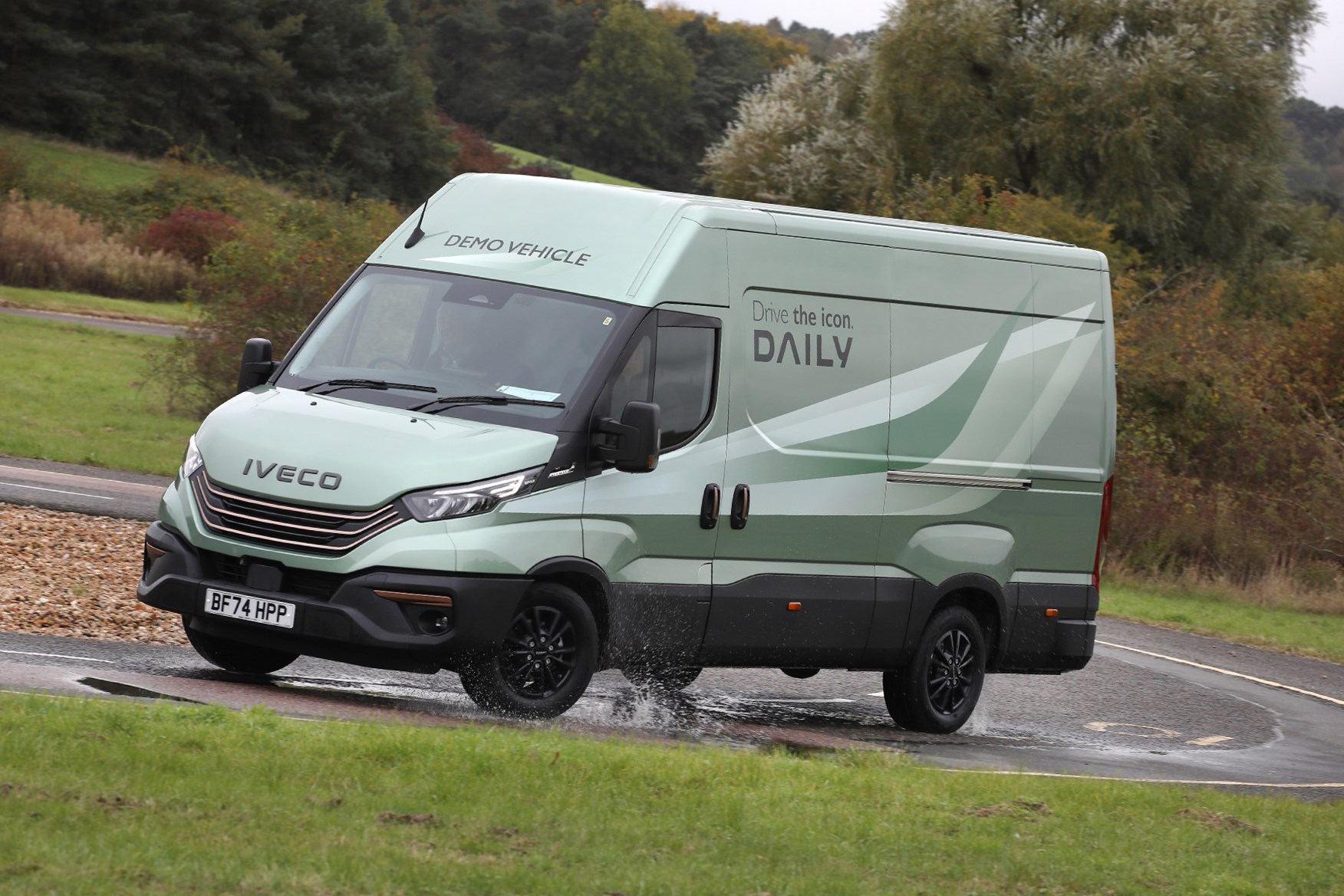
Changes over this time period include the integration of Amazon Alexa and some other clever connectivity features, increased safety levels, memory foam seats for better comfort, and the option of all-round air-suspension. For the MY24 version there are new digital screens, a revised cab interior, and further upgraded safety features, including modifications to the structure of the van.
Iveco Daily: the light truck of large vans
The version we are concentrating on here is the 3.5-tonne light-commercial Iveco Daily, but there are much heavier variants. Whichever version you go for, the Daily still has the driving position and sizing of a van, which make it much more city-centre friendly than a traditional 7.5-tonne truck.
At the same time, the Daily’s structure allows for some absolutely enormous body variants – particularly in terms of length. So if you need maximum space and some particularly high payload options, it’s well worth considering. The separate chassis makes it very capable in heavy-duty towing use, too.
To take advantage of the higher GVWs, however, you’ll need to have a suitable driving licence; those with regular car driving licences are restricted to a 3.5-tonne GVW maximum – at which point the Daily’s very strength becomes a weakness.
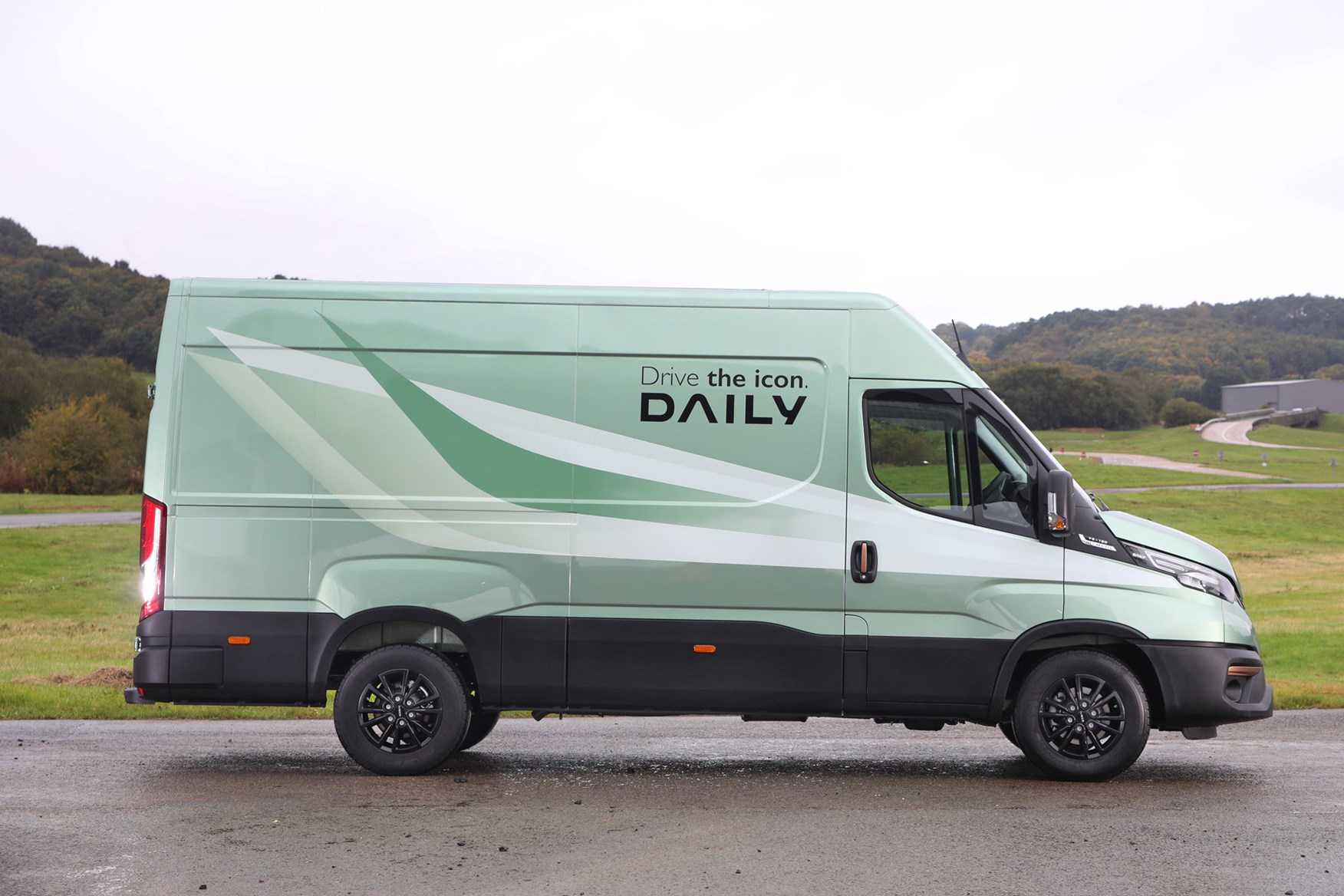
The tough build is so comparatively heavy that the available payload on a 3.5t GVW Daily is likely to be less than on any equivalent rival. This despite the current version being considerably lighter than previous generations. Optional lightweight wheels and chassis rails can carve 50kg from the basic weight of the van now, however, so if it was nearly but not quite useful for you previously, it could be more viable now.
It's also worth mentioning that the Iveco Driveaway range offers a greater number of body variants than any other large van in the UK. So if you need to order a tipper or a scaffolding wagon, there's a dealer process for that with the Daily that might make your life easier.
Perhaps unsurprisingly, given all of that, some two-thirds of Dailys sold aren't vans at all but some variant on the available chassis cabs.
Electric power steering, safety aids and tech
The Iveco Daily benefits from electrically power-assisted steering (EPAS), which brings it into line with the likes of the Volkswagen Crafter, Mercedes-Benz Sprinter and Ford Transit. As well as reducing steering effort, EPAS facilitates active safety aids, including proactive lane keeping assist.
The Daily is also available with adaptive cruise control, autonomous emergency braking and crosswind assist, while Hi-Matic automatic versions can be fitted with traffic jam assist, which can do the braking and accelerating for you when queuing in stop-start traffic. Hill descent control and a Traction Plus grip-finding driving mode are available, too.
A thorough amount of connectivity is available as standard on every new Daily as well, with Iveco offering a five-year subscription to a number of remote monitoring services as part of the purchase price. Called Iveco On, the uptime benefits of this include predictive maintenance that can alert you to a problem before the van actually breaks down.
Iveco Daily engines – diesel power and alternative fuels
Regular Daily models have either 2.3-litre or 3.0-litre four-cylinder diesel engines, with power output ranging from 116hp through to 210hp.
However, Iveco also offers alternative fuel vehicles in the form of the 136hp Daily Natural Power, which runs on compressed natural gas, and the electric eDaily, which was available to order from late 2022 for delivery in 2023. Both of these options are available for conversions and not just as vans.
All conventional models are rear-wheel drive, though you can get a 4x4 Iveco Daily. Though not as a 3.5-tonne model.
The excellent Hi-Matic eight-speed automatic gearbox is an optional extra that’s well worth considering, though the six-speed manual is unusually precise and engineered for a long working life.
Verdict: is the Iveco Daily any good?
Keep reading for our full review of the Iveco Daily, but suffice to say this is an impressive vehicle – especially if your priorities stretch beyond 3.5-tonne gross vehicle weight.
Pick the automatic, and the driving experience is easy-going, too, with light steering and engines that provide plenty of power.
Payload at 3.5-tonnes is a weaker area, however, and even after the 2024 update the cab interior remains outclassed by the best rivals for both quality and functionality.
As such, there are other large vans that may better-suit individual operators. But for heavy duty activities including towing, as well as the large number of available conversions, the Daily is definitely worth a closer look.
Skip to our full verdict on...
- Powerful engines are smooth and responsive
- Electric power steering from 2019 onwards
- Good long-distance comfort and controlled handling
The Iveco Daily’s engines are provided by Fiat Powertrain Technologies (FPT), which specialises in commercial and industrial power units. They come in either 2.3-litre or 3.0-litre four-cylinder turbodiesel configurations with the following output combinations.
Below you'll find the basic specifications for the 2024 versions, including an increase in torque (pulling power) compared with earlier variants.
Iveco Daily 2.3-litre (F1A) diesel engines:
- Model designation 120 – 116hp / 340Nm
- Model designation 140 – 136hp / 370Nm
- Model designation 160 – 156hp / 400Nm
Iveco Daily 3.0-litre (F1C) diesel engines:
- Model designation 160 – 160hp / 400Nm
- Model designation 180 – 180hp / 430Nm
- Model designation 210 – 207hp / 470Nm
All engines are available with either a six-speed manual gearbox or an eight-speed Hi-Matic automatic gearbox at extra cost – except the 120 2.3-litre engine, which is manual only, and the 210 engine, which gets the Hi-Matic as standard.
All of the 3.0-litre engines are rated Heavy Duty (meeting slightly less stringent emissions regulations as a result), while the 2.3-litre engines are available in Light Duty and Heavy Duty variants.
Drive is sent to the rear wheels.
Iveco Daily diesel engine performance
Even before the introduction of the electronically variable-geometry turbos (2019 onwards on all 2.3-litre Dailys and the 210hp 3.0-litre), we've always considered these to be lovely engines, with plenty of power from the entry-level upwards and reasonable refinement, too.
The move to e-VGT technology - a first in a van at the time - only enhances the impression of effortless performance. The electronic control acts with far greater speed and precision than the previous pneumatically controlled variable-geometry turbos could manage, meaning you get quicker engine response and the promise of improved fuel economy.
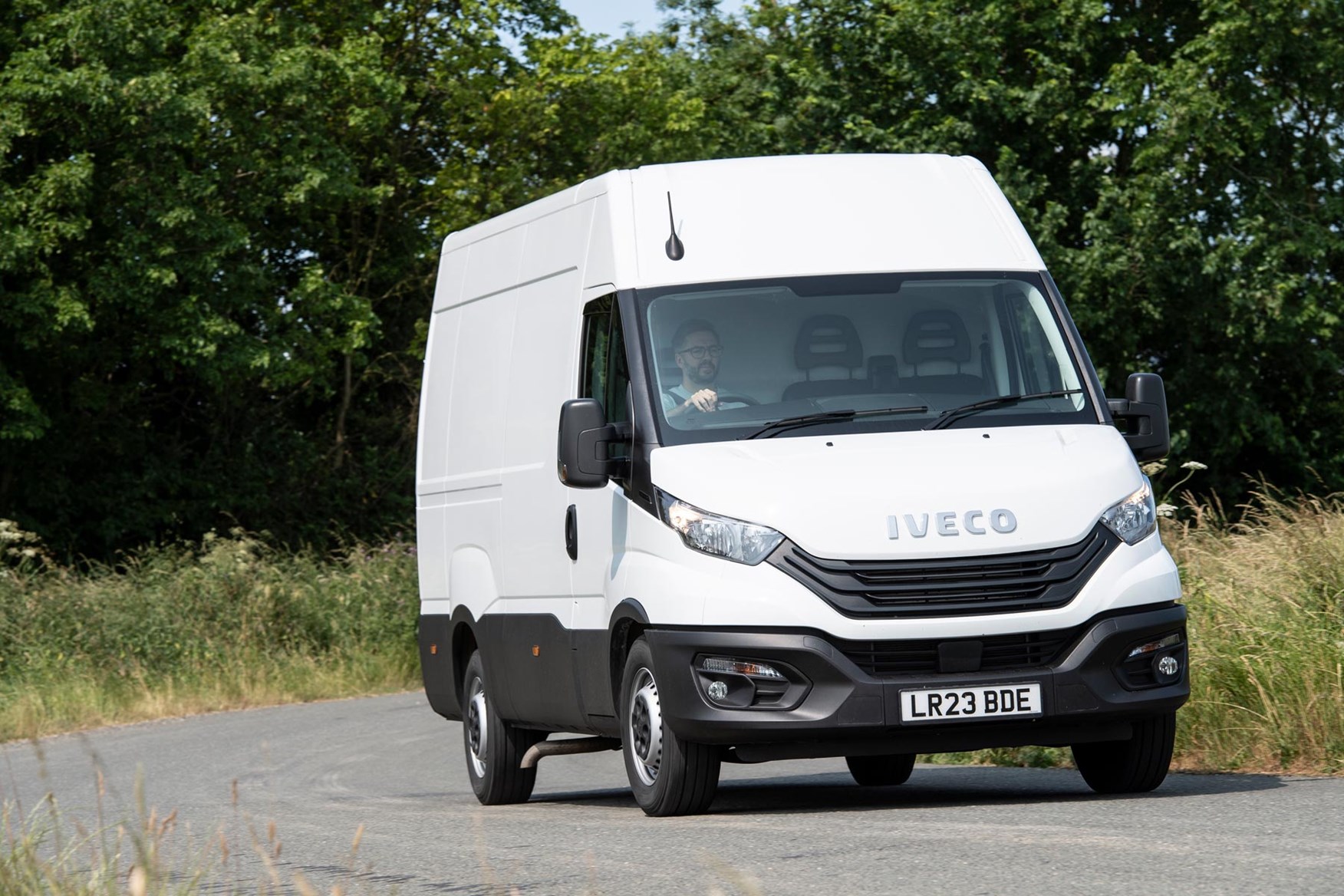
Sampling a 156hp 2.3-litre model, we found this still took a short moment to get going initially (unless you're brutal with the accelerator pedal), but once up and running you can really tell there's more engine capacity here than you get from the increasingly common 2.0-litre rivals. The Daily just feels more instantly muscular. Even the 136hp version has sufficient poke in most scenarios, although it does take a while to accelerate up to 70mph with a hefty load on board.
The Daily is not absolutely silent at speed - there's a particularly curious, though not unpleasant, roaring noise that comes in towards the top of the rev range, and we have experienced some vibration on right-hand drive models - but on the whole we've always found the loudest element of the experience to be wind noise at motorway speeds. There's really very little engine or road sound inside.
That said, the last 156hp Blue Power model we drove without the e-VGT system in 2018 effortlessly shrugged off a test weight in excess of 1,000kg, so if you can't afford the latest Daily engine range you'll still be getting a potent van.
We’ve also previously driven the longest possible Iveco Daily body variant – which is truly huge at over seven metres long – with the 180hp 3.0-litre engine. An engine this size is something of an indulgence these days, but its smooth performance almost justifies the expense. If you need power, the 3.0-litre Daily has plenty of it.
Iveco Daily gearbox choice
Driving two 160 models back-to-back did highlight the difference between the previous six-speed manual and the eight-speed Hi-Matic automatic transmissions, however. Given the choice, the auto is by far the better option - the older manual proving to have a lengthy and vague shift action that occasionally found us accidentally selecting too high a gear.
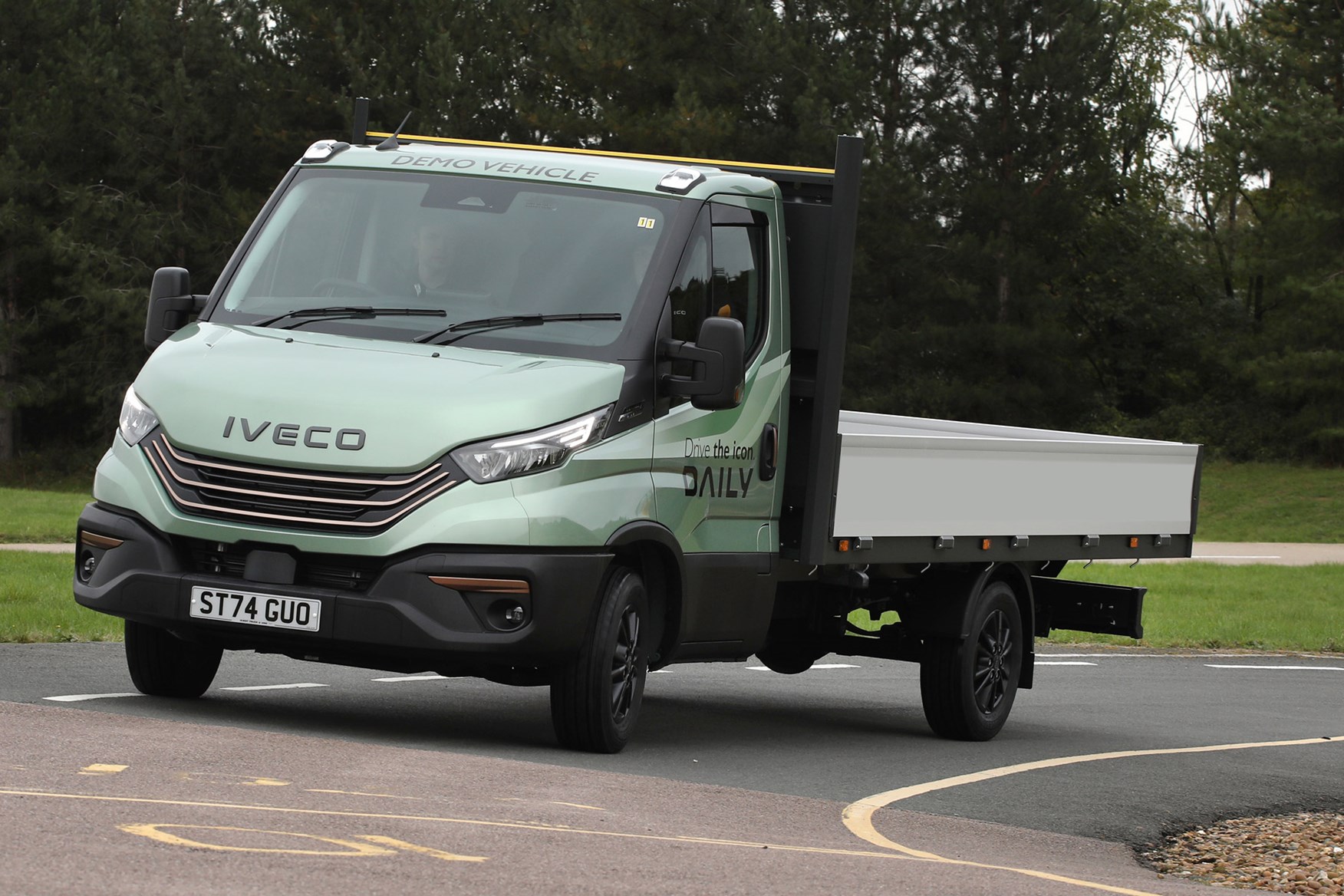
Buyers of newer Ivecos will be met by a much more precise manual gearbox now. The change is quite dramatically different, in fact, with the latest six-speed requiring a period of adjustment because it's almost too precise. It took us a moment to successfully locate third gear initially, as a result. But this faded with familiarity and the sense of direct robustness that replaces the previous vagueness is certainly our preference.
However, the upgrade cost to Hi-Matic is minimal, and it makes the Daily easier, quieter and more efficient to drive in the real world. It will also prevent clumsy drivers from prematurely destroying clutches and tyres, thus lowering your operating costs. The Hi-Matic can also be locked into a speed-restricted Eco mode via the connected services, a possibility that should reduce fuel consumption further still.
Iveco Daily ride comfort
This is a particularly heavy-duty van, and this is reflected in the unladen ride quality – which is bumpy, to say the least. This is especially noticeable over rippling B roads, with the traction control light flickering as the rear wheels occasionally skip over particularly vicious surface intrusions.
Put a bit of weight in the back, however, and you’ll find this gets better. Not perfect, compared with more modern vans such as the VW Crafter and Mercedes Sprinter, which still have the edge in this regard. But acceptable enough to make longer journeys tolerable.
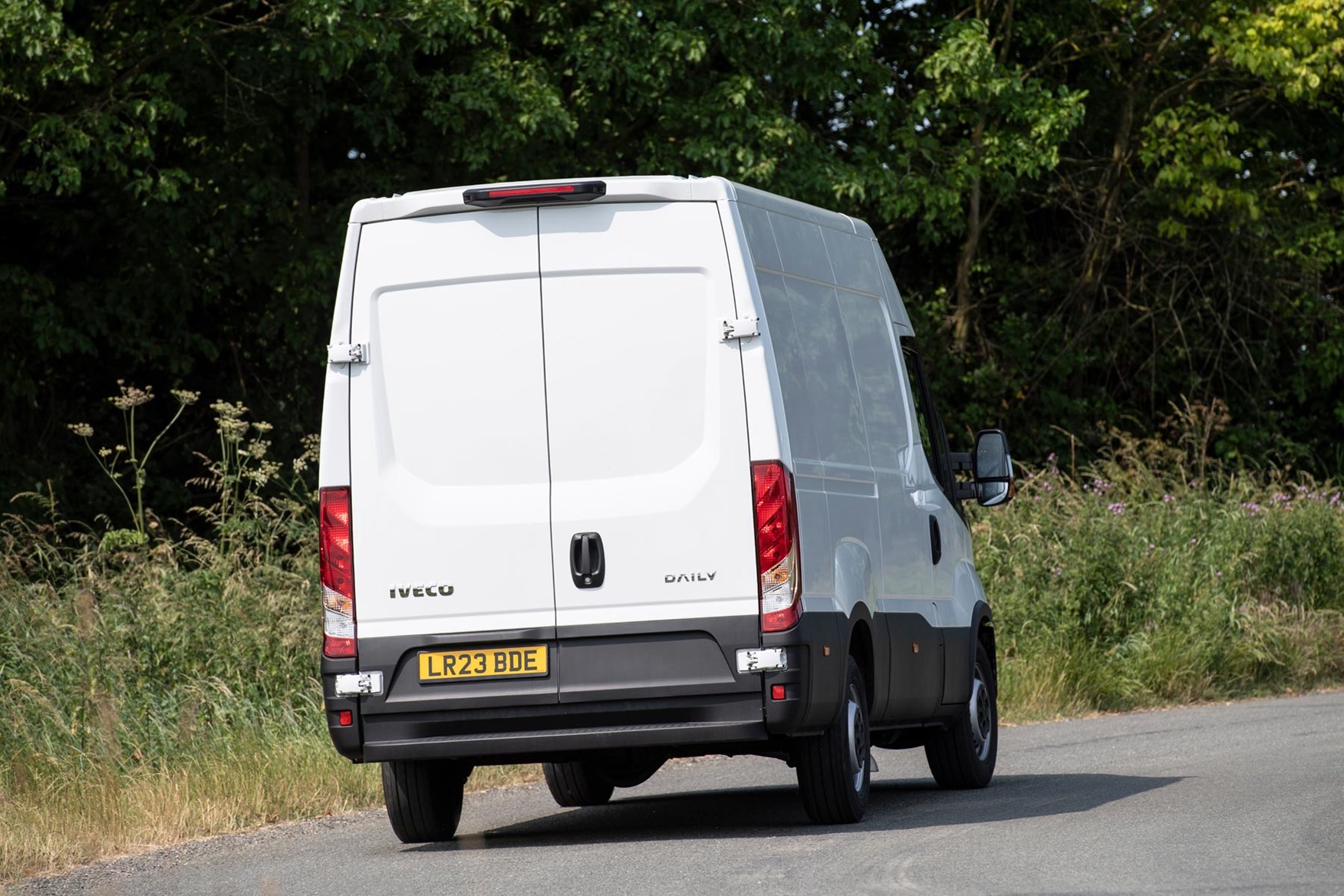
You can make life even better for the driver in this regard by specifying a suspension seat that helps cushion the worst of the road surface further. Passengers aren't afforded such luxury, however, so care still needs to be taken over the nastiest bumps.
Iveco does offer an all-round air-suspension system call Air-Pro, but although this sounds very clever we've never been given the opportunity to test it. It's also only really suitable for lighter loads.
Iveco Daily steering and handling
The Daily's steering has always been light, making it surprisingly easy to manoeuvre for such a big vehicle. It also has a remarkably small turning circle - though watch the rear over-hang on the longest variants.
The flipside to this convenience is a slightly dead area around the straight-ahead position on later models fitted with the electronically power-assisted steering, which creates an odd sensation akin to a piston moving suddenly through oil as you push beyond this point to turn the van into a corner.
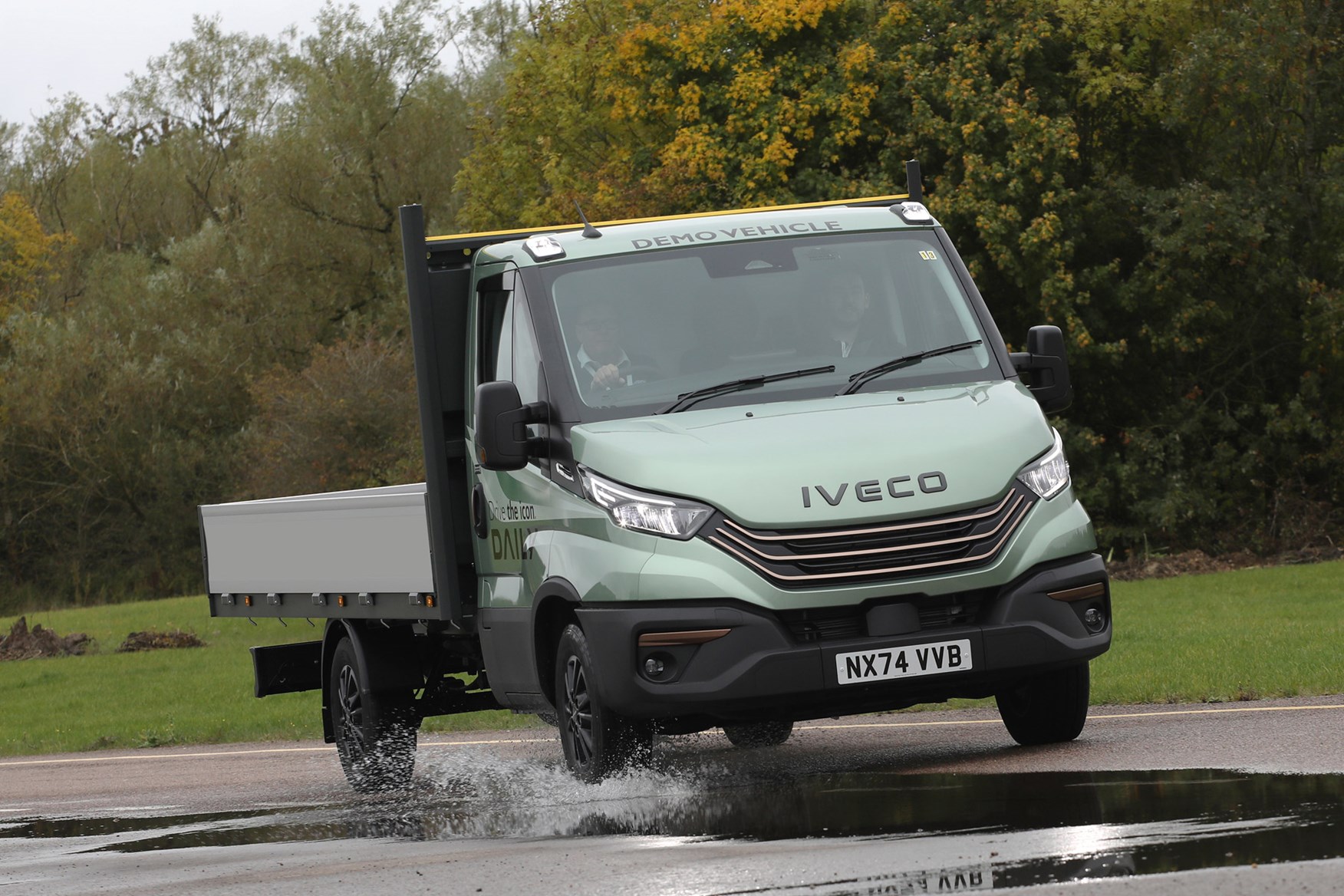
Still, we've always found the Daily straightforward enough to keep pointing in the right direction on the motorway - helped by the smooth and gentle intervention of the lane keeping assistance system, which is far less aggressive than some rival equivalents. It always feels well-controlled when tackling high-speed slip roads, too.
It's not quite as car-like as a Sprinter or Crafter, but for a vehicle with a separate chassis it does a good job of disguising what could be a jarring difference.
Iveco Daily Natural Power performance
Iveco is a rarity in that it also sells the Daily with a 3.0-litre CNG engine powered by compressed natural gas, called the Daily Natural Power.
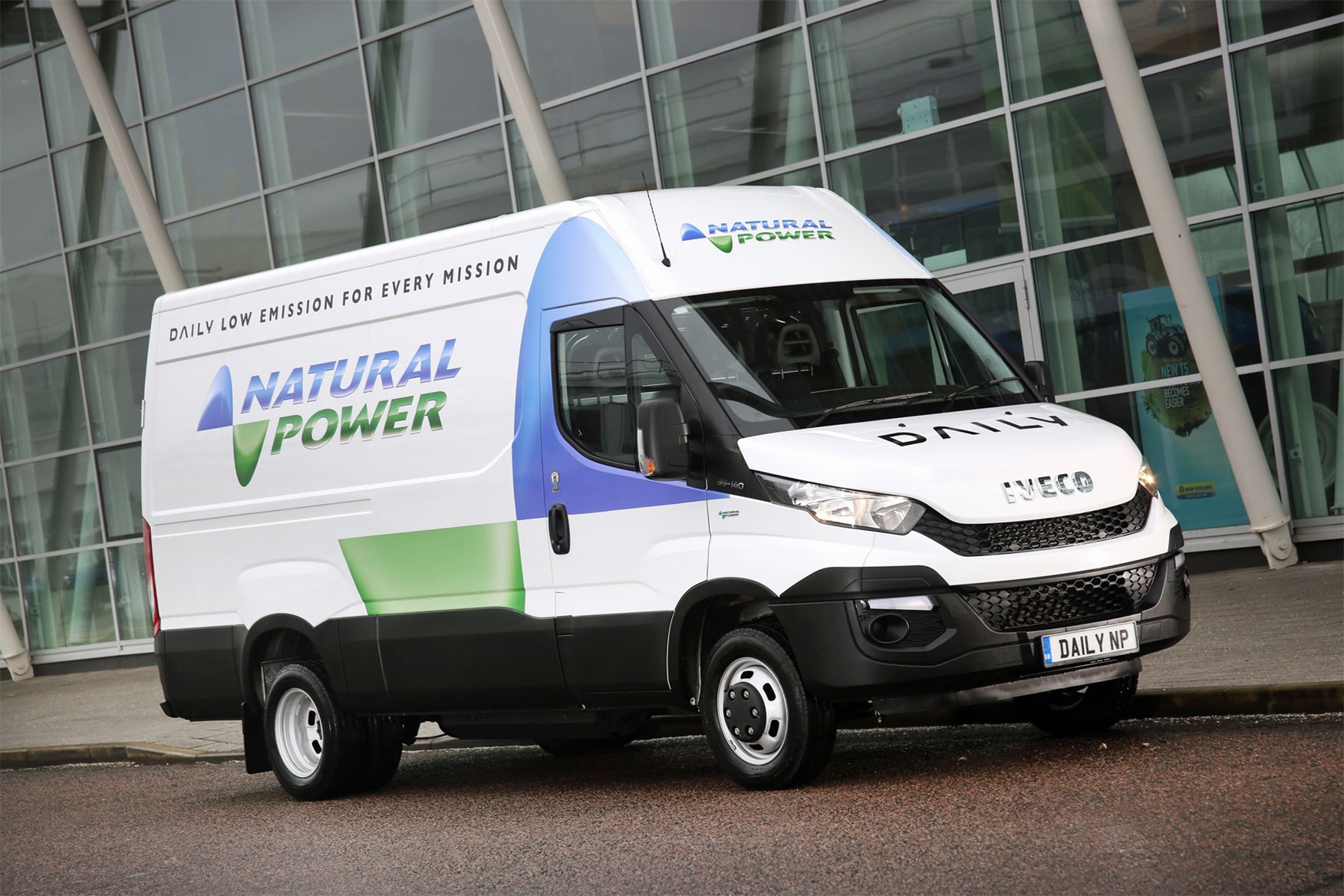
This produces 136hp and 350Nm of torque, so again is hardly lacking in get-up-and-go. Compared to the diesel alternative it’s also quieter and more refined – and still capable of hauling a 7.0-tonne Daily loaded with over 3.0-tonnes in the back.
We've got a full Iveco Daily Natural Power review on a separate page.
- Smaller steering wheel, good interior tech, electric parking brake
- Plenty of in-cab storage, decent comfort levels
- Build quality and plastics lag well behind the best in class
Compared to some rivals, the Daily retains an almost forward-control style of driving position despite the nose poking out front; the steering wheel is quite flat, the pedals need a bit of leg-lifting to operate rather than ankle-flexing, but nothing is heavy, or crude in operation, and visibility out the front is good.
In 2019 Iveco brought in a smaller steering wheel, with adjustment for both reach and rake for the time. It also added a central TFT display to the instrument cluster, and a new Hi-Connect infotainment system option. 2022 brought the integration of Amazon Alexa, too, so you have a greater degree of voice interaction with your van.
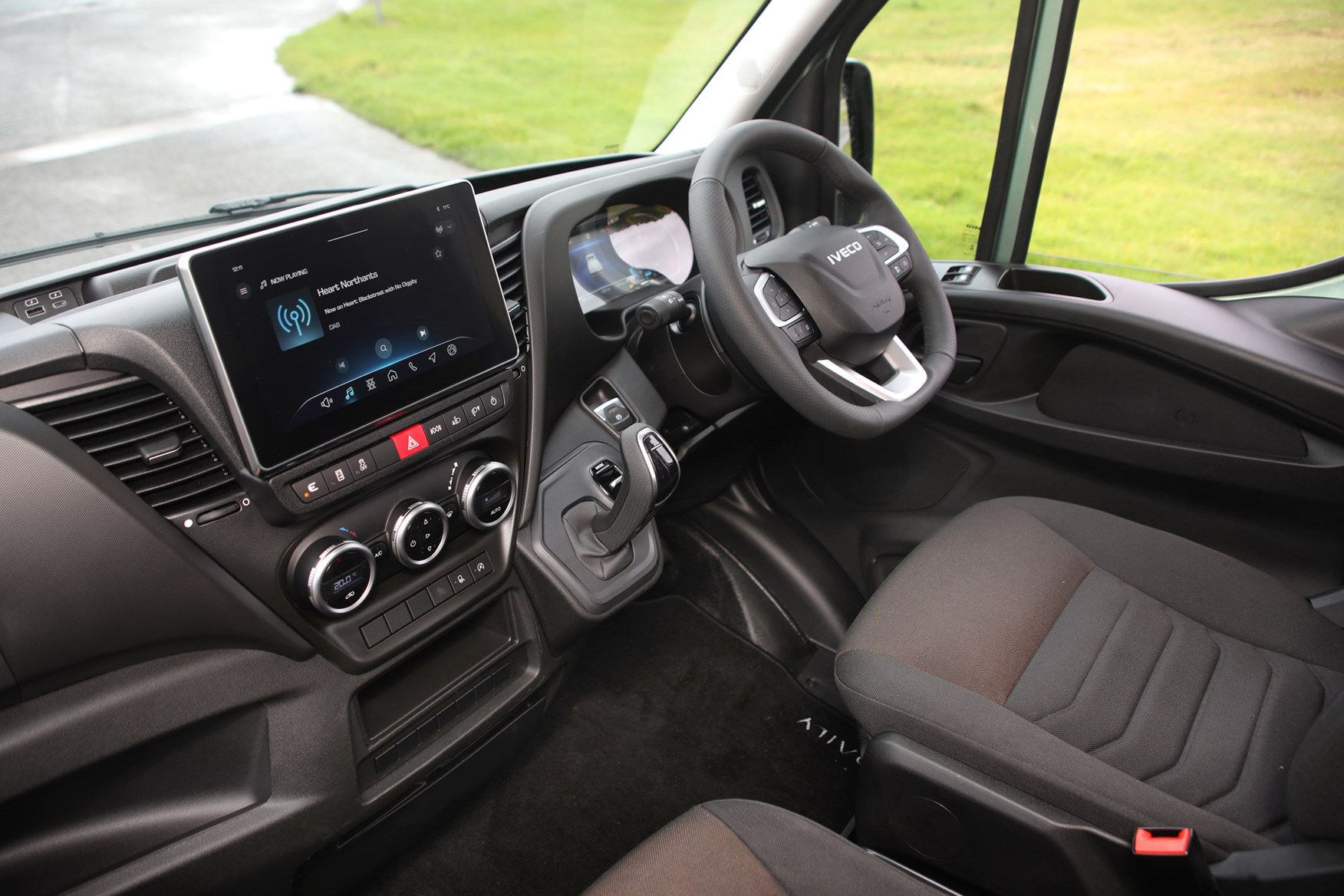
For 2024 (above) there has been a bigger change, with a redesigned dashboard and new screens - including a fully digital instrument cluster as standard. The numerical speed display is intended to help drivers stay compliant in a world where 20mph limits are no longer uncommon, but there's plenty of customisation available for the display to show what's most important to you.
Redesigned cab for MY24
You get a choice of 7.0-inch or 10.0-inch infotainment screen, with software that's reasonably easy to navigate if not exactly super-slick compared with the likes of the Mercedes Sprinter. The option of built-in Amazon Alexa and TomTom navigation that accounts for vehicle size does give it some smarts you don't see everywhere, though, and you can connect via Android Auto and Apple CarPlay, if you prefer.
Better yet, the new single-piece dashboard is intended to cut down annoying squeaks and rattles, while the addition of a rather clever tablet holder on the top makes dealing with in-cab devices more straightforward. We found this will hold a smartphone steadily during vigorous driving with no problem at all. There are also more USB ports and a wireless charger as well.
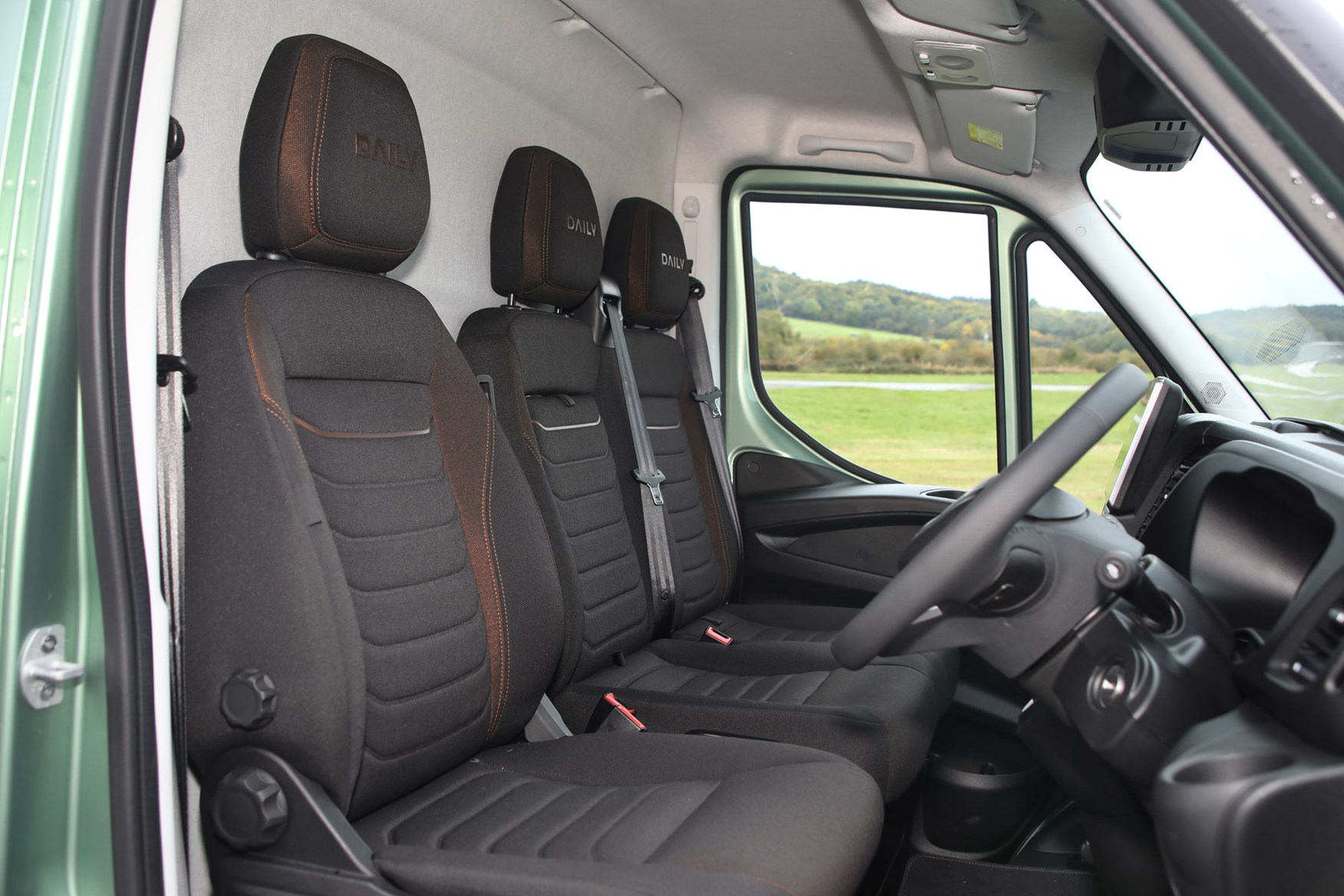
Plastic quality isn't especially premium - Iveco going instead for durable - and you do feel rather perched on top of things. The seats also don't go very far back; even at 5'11" we were right up against the bulkhead, so it is a little cramped inside and taller drivers may struggle for leg room.
There is plenty of storage, however, and there are still very easy to use controls for the heating and air-conditioning as well as plenty of other buttons. Meanwhile the continued use of memory foam for the redesigned seats should make them more comfortable and more robust longer-term than in many rivals. The driver's bolster nearest the door, for example, is said to be much more resistant to wear than a conventional design.
- Not the best for fuel economy
- Truck-level servicing but limited UK dealer network
- Predictive maintenance and alternative fuels
It’s all swings and roundabouts when it comes to Iveco Daily running costs, as the advantages of long service intervals, a five-year warranty, truck-based servicing provision and design features such as the three-piece bumper (meaning only the damaged section need be replaced) attempt to balance out the fuel economy data and hefty basic weight of this vehicle.
Iveco Daily mpg
The Daily is always going to struggle to deliver fuel economy that will challenge the top of the class, due to its heavy-weight, truck-style construction.
Iveco has been making efforts to increase the miles-per-gallon (mpg) over time, however, with the 2022 updates bringing about a 6% improvement. Even so, the official figures see it scarcely scrape 30mpg, and fully loaded in the real world you're going to be doing much worse than that.
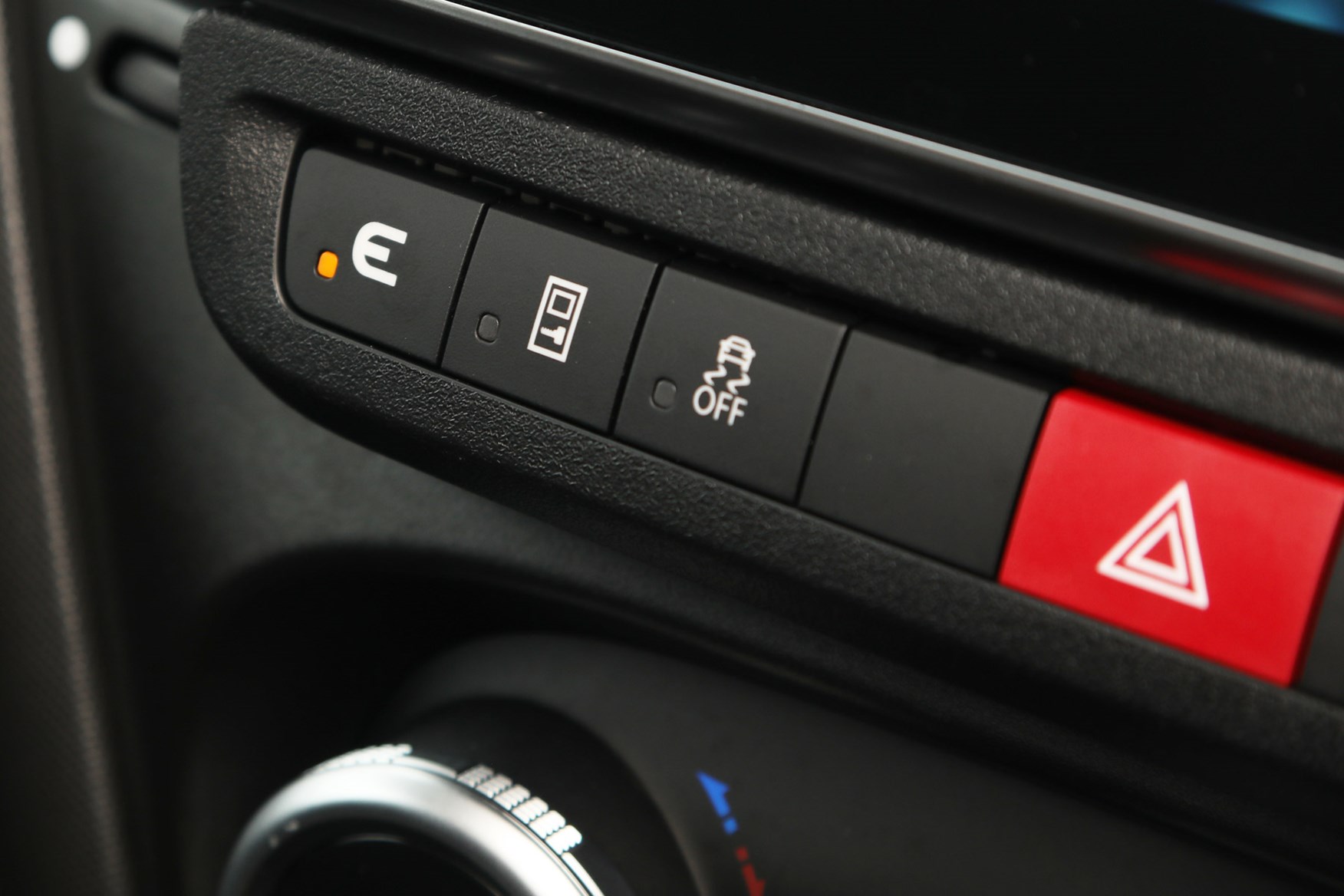
There is an Eco button in the cab, which optimises efficiency at the cost of some performance, including restricting top speed (the restriction varying with model year). There's also a high and low power setting when you opt for the Hi-Matic transmission, which can save some fuel if used judiciously.
Iveco Daily warranty and servicing intervals
The Daily comes with a five-year, 100,000-mile warranty as standard, which is among the best in the van sector.
Upgrades in 2019 also extended service intervals up to 60,000km – the equivalent of just over 37,000 miles – which no other van maker can currently match. New gearboxes in 2021 extend clutch service life and, indeed, suggest a 350,000km (217,000 miles) expected lifespan for the manual gearbox.
Truck-level servicing access for the Iveco Daily – but limited dealer network
The Daily benefits from a dealer and servicing network that’s geared up to support trucks. This means extended opening hours - including on a Sunday - so it should be easier to find a time to get your van serviced that doesn’t inconvenience your business.
There’s also Iveco’s Assistance Non Stop (ANS) breakdown service, which operates 24 hours a day, every day of the year.
Iveco offers a variety of servicing and maintenance packages to help spread costs and allow you to customise the provision to your needs, but the actual dealer network is on the small side. So you may have to travel further to take advantage of all this.
- Built tough, and should be reliable, too
- Has connectivity to predict breakdowns before they happen
- Truck-level support should get you back on the road faster
The Daily has a reasonable reputation for reliability historically, with the previous version only really bothered by less serious common faults - ball joints, binding calipers and injectors being the main worries.
As previously mentioned, Ivecos benefit from truck-level aftersales, which means thorough servicing and the dealers are usually well stocked on parts, which tend to be reasonably priced.
The 2.3-litre engine from Fiat Powertrain Technologies has been in use for years in the Fiat Ducato, and is also fairly well respected for reliability and efficiency.
Connectivity for remote diagnosis and repair
An impressive degree of built-in connectivity allows Iveco's service technicians to remotely log into the van to perform diagnostics tests.
This means that if you see a warning light come on, you will no longer need to visit the dealer to find out what the problem is - at least in some cases. You can even ask Alexa for your van's status via Iveco's 'Driver Pal' gadget.
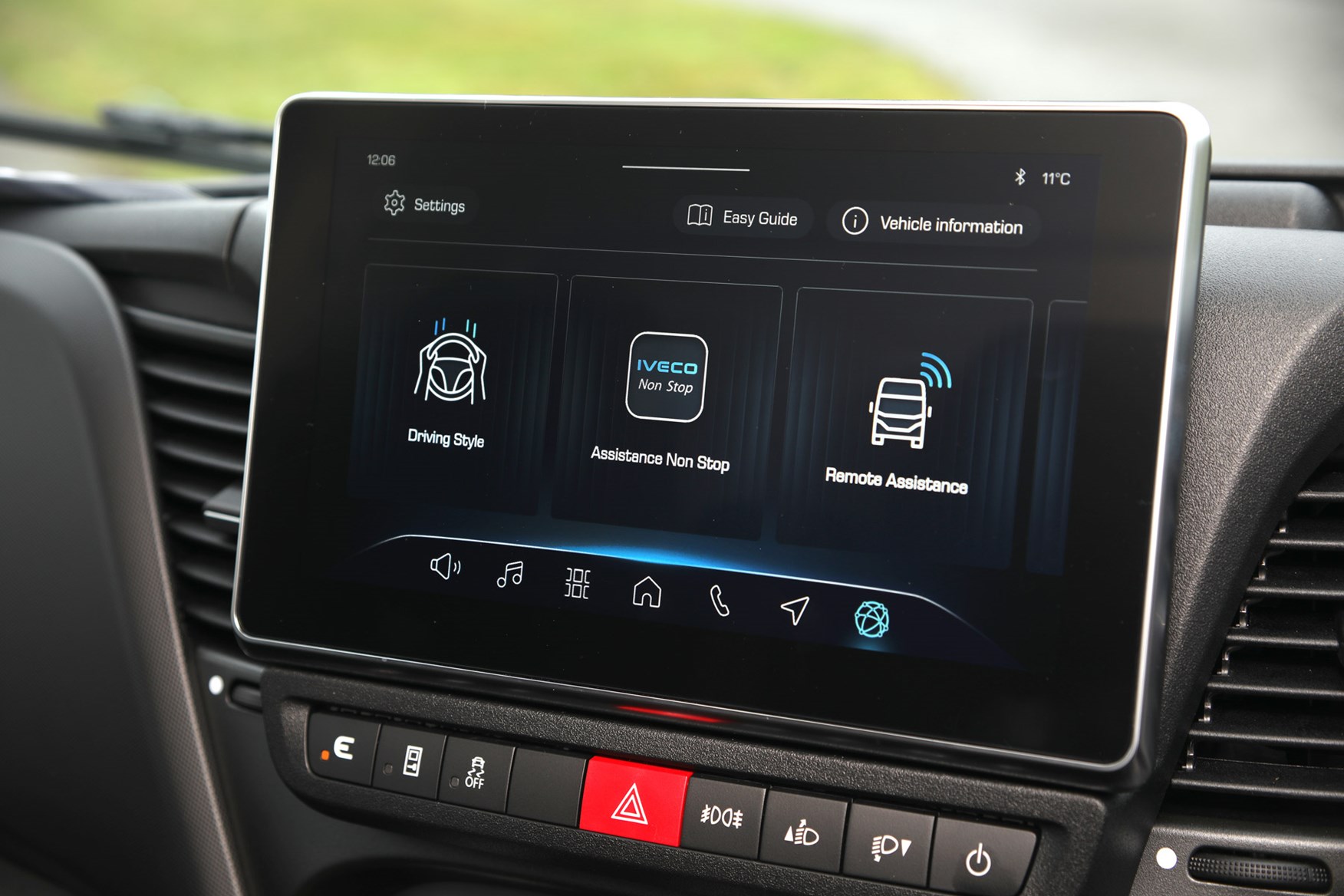
If it's a software issue, Iveco reckons it will even be able to repair the problem remotely as well, assuming an update for the offending code is available.
Clever stuff, if it works, as it should save you the cost of unanticipated downtime. Along similar lines, the predictive maintenance capability, built-up from the data available from all of Iveco's connected vans, means in some case the company can detect a problem before it happens.
- Lots of standard safety kit thanks to latest EU regulations
- Improved passive crash safety for front, side and rear impact
- Euro NCAP Gold rating: 'a good choice for a safe van'
The Daily has gone from being a bit of a laggard when it comes to safety kit to one of the best in the large van class with the 2024 update, thanks to the need for compliance with the EU’s latest GSR rules. If you’ve been watching too many crime dramas, you might be wondering what gunshot residue has to do with anything – but in fact GSR stands for General Safety Regulations and covers the minimum standard equipment new vehicles now need to come with.
This is European legislation, and therefor isn’t yet law in the UK, but Iveco is applying it to UK vans anyway. The requirements also vary slightly between 3.5-tonne vans and heavier models, but fundamentally it means that the Daily now has a comprehensive set of radar sensors and camera systems available.
Lots of standard active safety equipment
Key items that all Daily models now come with includes autonomous emergency braking, intelligent speed assist (warns you if you’re over the speed limit), driver drowsiness detection, reversing detection (sensors with the option of a camera), automatic low beam control headlights (stops you forgetting to turn off the high beam), tyre pressure monitors, and emergency stop signal (activates the hazard warning lights when braking hard).
They also get ‘alcohol interlock preparation’ – which will in time prevent the van from being started if the driver is over the alcohol limit. The regulations also equip 3.5t vans with emergency lane keeping (which works with commendable subtlety here, compared with other systems), and an event data recorder.

Above 3.5t you don’t get those as standard but you do get blindspot monitors and lane departure warning as well as a ‘moving off information system’. This last is designed to stop you pulling away into an object in front of the van you might not have seen.
Optionally, a door opening warning can let you know if a cyclist is approaching, turn assist braking stops you turning across a road in front of oncoming traffic, and rear cross traffic braking will help if you’re forced to reverse out of a parking space by detecting vehicles behind you approaching from the side.
Passive safety upgrades
In addition to the active safety kit, the 2024-onward Daily comes with two airbags as standard, a new front crash box to better withstand high-speed impact, and reinforced chassis rails that together with redesigned fuel tanks (for the diesel versions; the CNG model stays as it was) and intended to improve side impact-protection.
There’s also improved rear impact-protection. Curtain airbags are optional.
Euro NCAP Gold rating
All of the above has helped the 2024 Daily improve to a Gold rating under the Euro NCAP commercial van safety scheme – the 2023 model was only rated Bronze, so that’s a hefty upgrade. Euro NCAP even said the Daily was ‘unlucky’ to miss out on a Platinum rating.
Apparently the inaccuracy of the speed limiter held it back. So don’t rely on that too much to avoid a ticket. This aside, Euro NCAP says the Daily ‘represents a good choice for those looking for a safe commercial van.’
Fleet safety
To make sure drivers can’t circumvent these improved measures by switching the active safety aids off or reducing them to their minimum settings, the same connectivity that's used for telematics can also be used by fleet managers to lock the Daily into its maximum safety settings.
Similarly, the electric handbrake can be linked to various safety features in the van – for example, not releasing unless the driver is wearing a seat belt.
Other features on the Daily's comprehensive options list include an electromagnetic retarder, which provides a braking force of up to 470Nm and reduced brake wear, wider wheel profiles, and rear air suspension for ease of loading and unloading.
Which IVECO Daily is best for me?
The Iveco Daily offers an extensive number of body sizes - which you can learn more about on our dedicated Iveco Daily dimensions page - while its truck-style chassis means it's very suitable for a wide-range of conversions.
As such, you're very likely to be able to find a Daily variant to suit you.
Especially given the number of engine options, covering traditional diesel as well as CNG and electric power.
However, remember that payload at 3.5-tonne gross vehicle weight isn't especially high.
Whatever Daily you choose, we recommend the Hi-Matic eight-speed automatic transmission option, where available.
Iveco Daily version reviews
We've tested a number of particularly interesting Iveco Daily variants over the years. Here you'll find links to more detailed reviews of some of these.
Iveco Daily CrewVan review - tested August 2021
Iveco Daily 4x4 All-Road and Off-Road review - tested June 2021 (opens in new window)
Iveco Daily 7.0-tonne review - tested November 2020
Iveco Daily Natural Power review - tested October 2019 (opens in new window)
Iveco Daily 3.5t CrewVan review
Tested August 2021 by Alan Taylor-Jones

- Multi-seater CrewVan conversion by Snoeks
- Roomy for people and gear
- 136hp engine needs time to get going
To give you an idea of just how much choice there is in the range, we’re taking a look at one of the smallest and least powerful versions here, the 3.5t Iveco Daily CrewVan by Snoeks. Open the rear doors and you’ll find not just a load area, but three or four back seats, making this the perfect option for those or need to take both crew and equipment to a job.
Under the bonnet is the mid-range 2.3-litre diesel with a fairly tame 136hp coupled to our preferred Hi-Matic eight-speed automatic gearbox. A six-speed manual is also available for those looking to save a few quid, and this engine is sandwiched between a lesser 110hp 2.3 and a punchier 156hp version. There’s also the 3.0-litre if you need even more.
Inside the Iveco Daily 3.5t CrewVan
Just because this is one of the dinkier Dailies doesn’t mean it’s cramped up front. You’ll find a driver’s seat with a good range of adjustment with a two-person bench to the side. Space is plentiful although the seats could do with a bit more padding to stop your posterior going to sleep.
The steering wheel adjusts for reach and rake to help comfort further and there’s the option of plenty of useful kit. We’d certainly recommend the air-conditioning with such big windows, while the Hi-Connect infotainment system is fairly easy to use and comes with navigation and smartphone mirroring. It does take a fair while to load initially and isn’t as user friendly as Ford’s Sync 3 system, though.
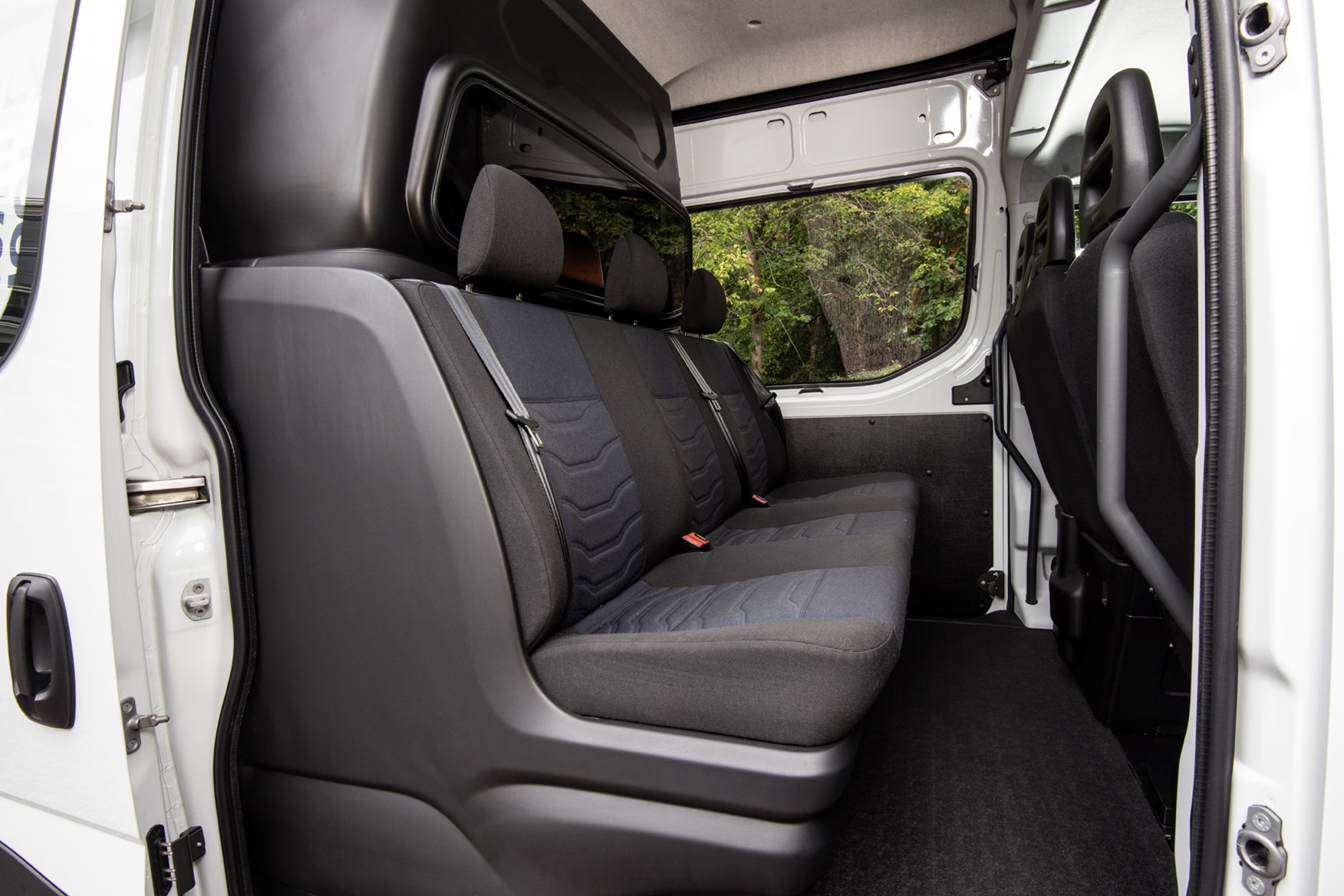
The steering wheel’s odd shape won’t cause any issues, although the hidden stereo controls on the back take a little getting used to. The other buttons are more conventional, making it easy to operate the optional adaptive cruise control and scroll through the digital information screen between the dials.
Quality is certainly not offensive with everything solidly screwed together, but this interior isn’t as attractive as what you’ll find in a MAN, Mercedes or Volkswagen. A few chrome highlights help lift things a little, but the blue panels are a little too cheap and cheerful for us.
Like the front, you’ll need to clamber up into the rear seats – thank the Daily’s hefty separate chassis for that. Once there the three-person bench has ample width and leg room would shame most luxury limos. As for head room, there’s enough to stand up if you’ve got the H2 roof.
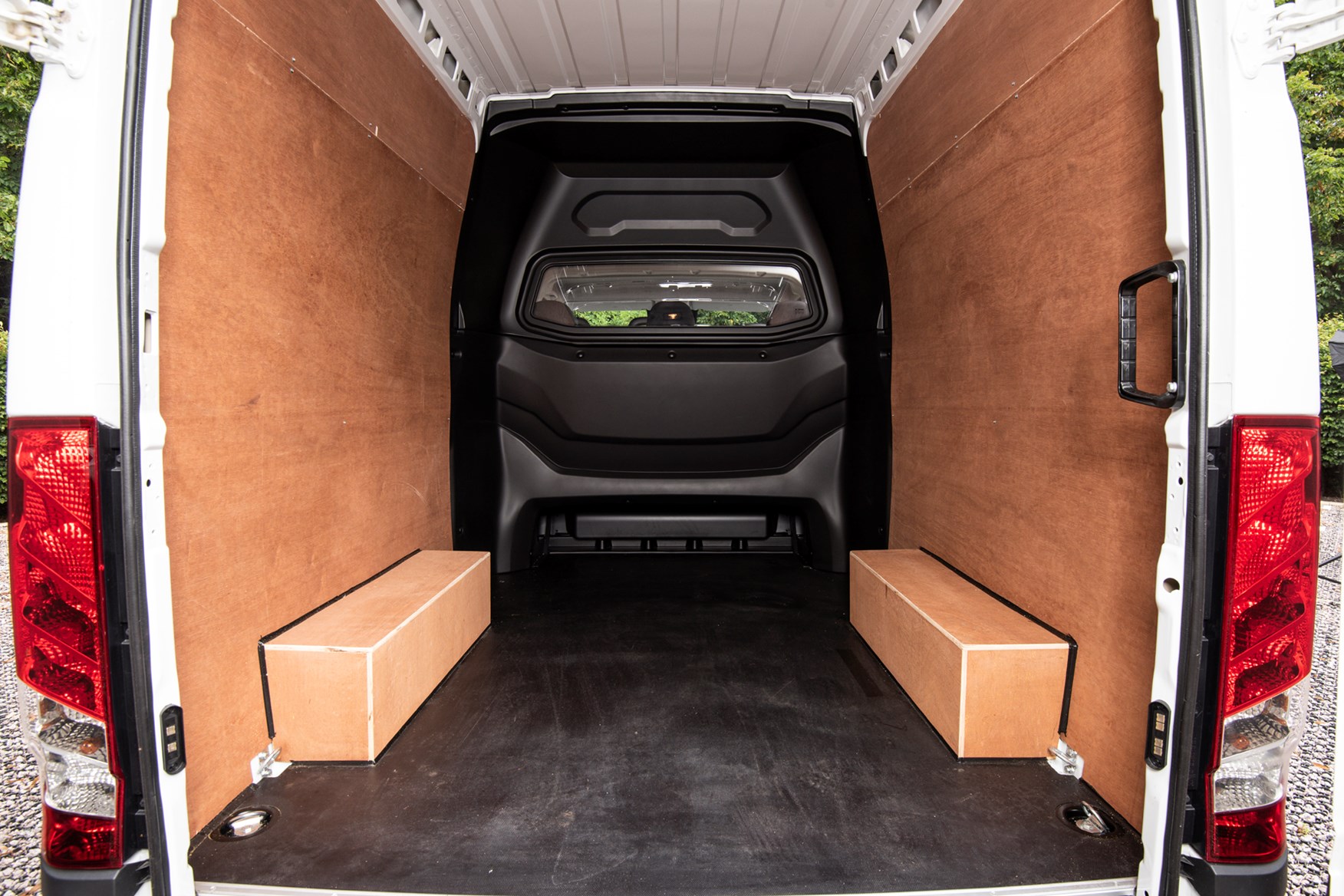
Of course, the addition of the bench and bulkhead does limit your payload, dropping from 1232kg in a regular panel van to 1001kg. It also reduces the length of the load area to 1,950mm (2,555mm if you go under the rear seats) from 3,130mm for the same size panel van. Still, this is a tall, wide area that even with some wheelarch intrusion, will still swallow an awful lot of stuff.
Driving the Iveco Daily 3.5t CrewVan
The 136hp output of the diesel engine is more than adequate in the majority of situations. Even with a hefty load on board, it’ll sit at 70mph all day long with no drop in speed on the inclines we encountered. However, it takes its time getting from 60-70mph when loaded, suggesting one of the more potent engines is worthwhile if you regularly have to deal with a weighty cargo or fast-flowing motorway.
We’ve certainly no complaints regarding the eight-speed Hi-Matic automatic gearbox. As you’ll read elsewhere in this review it changes gear exceptionally smoothly and is responsive when you put your foot down. If anything, it’s better than many car gearboxes, while the tall eighth gear makes for a surprisingly quiet cruise. It also means we were able to virtually match Iveco’s official economy figures, with over 27mpg achieved regardless of load.
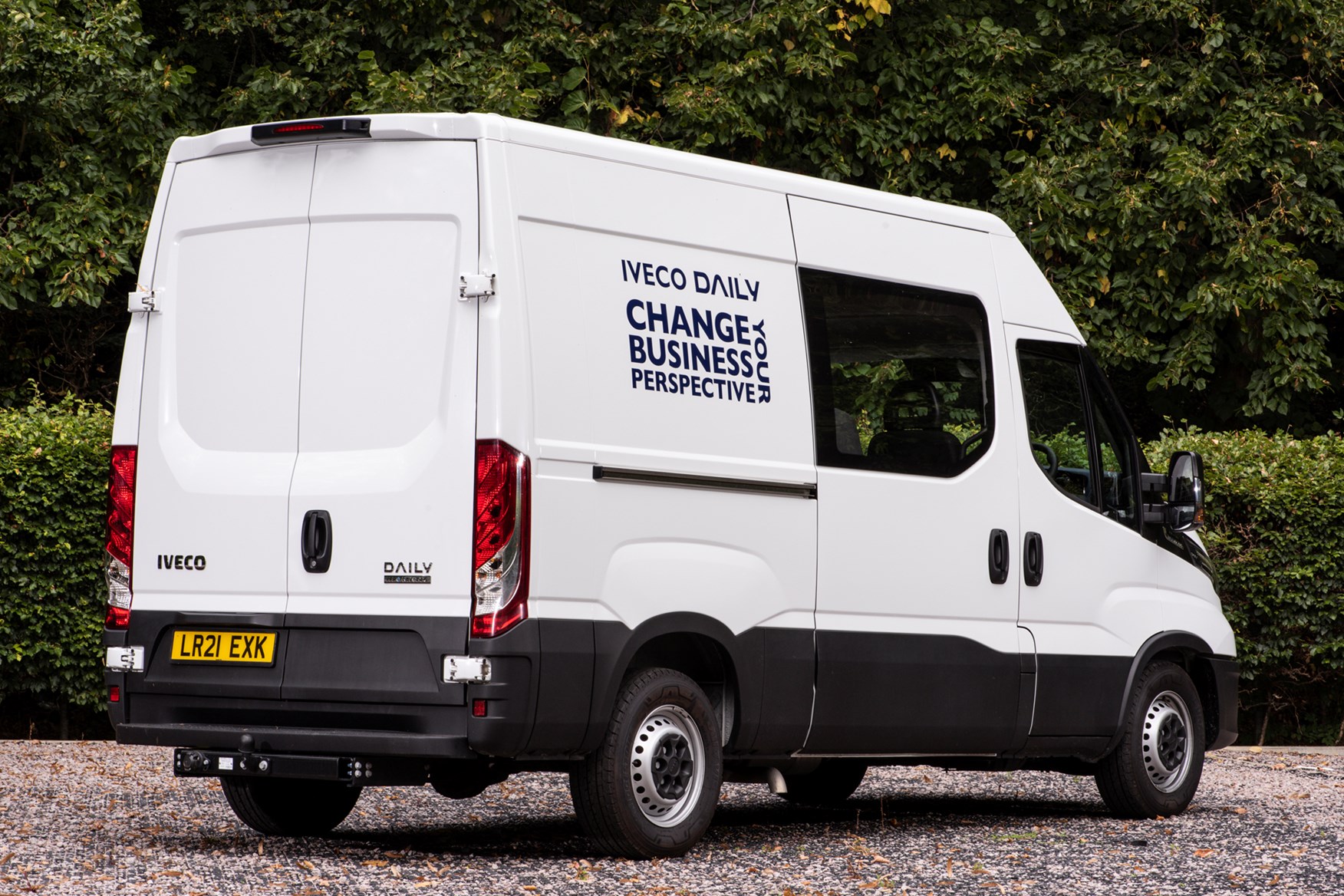
How the Daily rides depends entirely on how heavily loaded it is. With a few hundred kilos in the back it’s actually quite comfortable, with only the odd thwack from a particularly vicious pothole or pimple really disturbing things. Unladen it’s far bouncier, with the rear tyres skipping across undulating road surfaces, triggering the traction control regularly when you’re trying to accelerate.
As for handling, it feels stable and doesn’t sway around too much even with a bit of a gust. There’s plenty of grip, precise steering that makes it easy to place and an acceptable amount of body lean.
Should I buy an Iveco Daily CrewVan?
How useful the CrewVan element of this is will depend entirely on your circumstances. In other words, if you need to carry up to seven and up to a tonne in the back, it’s certainly worth considering.
Yes, it does have its downsides compared to less ruggedly constructed vans with the high floor and relatively low loading weight counting against it, but overall this is a van you can easily cover hundreds of miles in relative comfort.
The 136hp engine is sufficient if you’re in no hurry and economy isn’t terrible, either. We’d recommend the Hi-Matic gearbox, too.
Iveco Daily Business 7.0t review
Tested November 2020 by Richard Kilpatrick
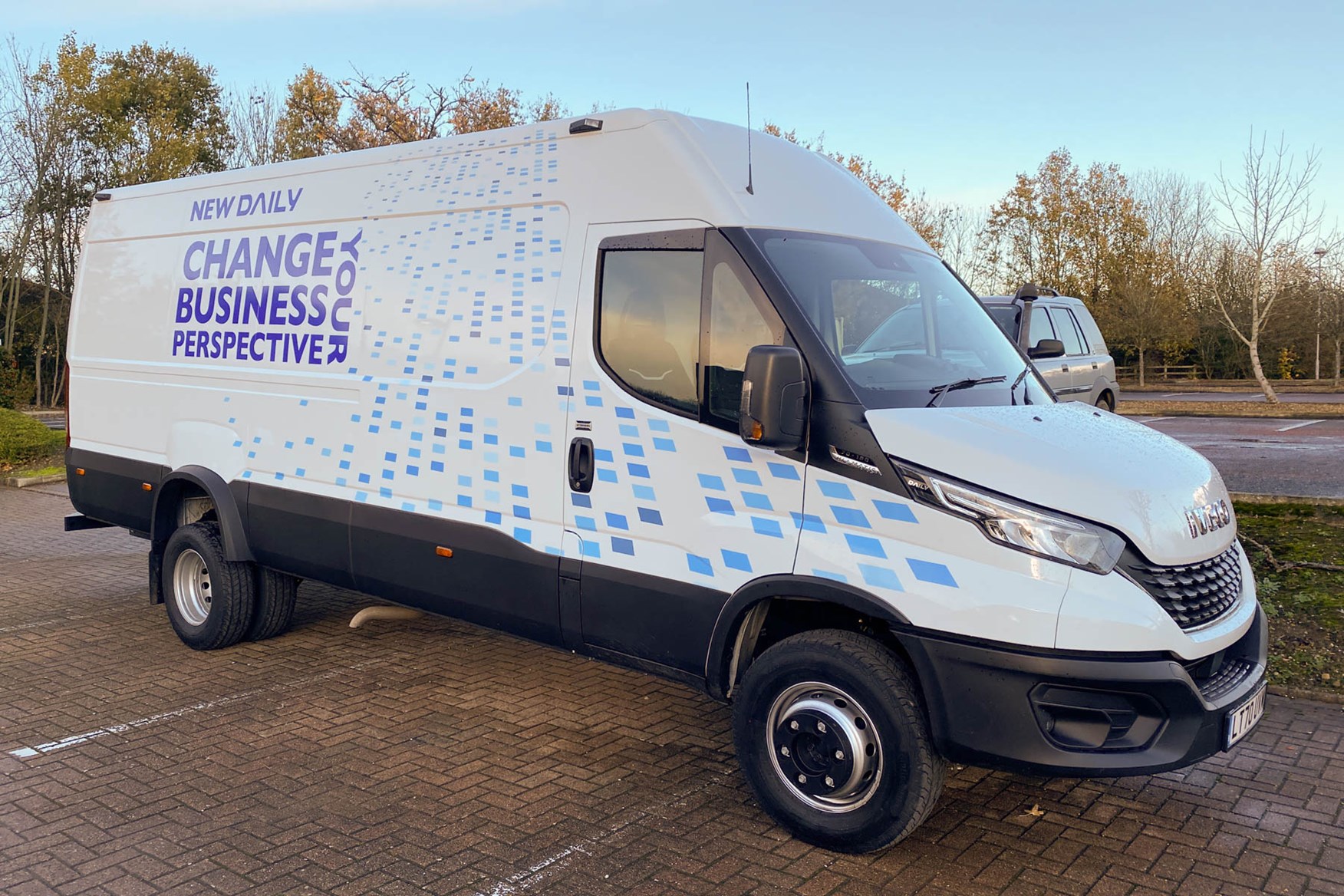
- Massive 7.0-tonne Iveco Daily tested
- As big as you can go without driving a truck
- Impressively capable, with payload over 4.0 tonnes
This is the big one, the 70C18HA8 V - C70V in Iveco terms. For van drivers, it's not far off the biggest you can get and still call it a van and it's not so much the space, as the mass it can carry. Iveco's higher-GVW Daily chassis obviously has huge scope for conversions, but it's also offered with the same bodies as less-muscular Daily vans. In Business Plus form it the ability to carry over four tonnes, and a couple of nice bits of kit for drivers.
Everything about it is imposing – the incredible ground clearance, dual rear wheels (which include tyre pressure monitoring on all four rear tyres) and the 3.0-litre, 180hp engine that's cut of a different cloth to the 2.0-litre units found in vans such as the MAN TGE, Volkswagen Crafter or Ford Transit.
Iveco build the Daily on a proper chassis, so the first hurdle is the loading height – literally. With the rear bumper sitting around hip-height the floor is at a level convenient for just reaching in and grabbing things – no bending down required. Combined with a 1.9m internal height, this is a van for two operators to make short work of deliveries; one rearranging the stock, the other loading and unloading.
With this payload, the chances are you'll be carrying the sort of things that need two people to lift anyway.
Inside the Iveco Daily Business Plus
The cab's big enough for two with plenty of social distancing – the two-seater bench is generously wide, though not generously padded (the same criticism can be levelled at the driver's seat after a working day) and three adults.
There's a big footwell step and an A-pillar handle, and you'll need them unless you've been practising your parkour.
Having clambered up, the Iveco's interior is solid, functional but not unattractive or crudely finished. The controls feel car-like, delicate – from the heating system to the steering, there's even a Fiat 500-esque City mode for even lighter twirling of the wheel.
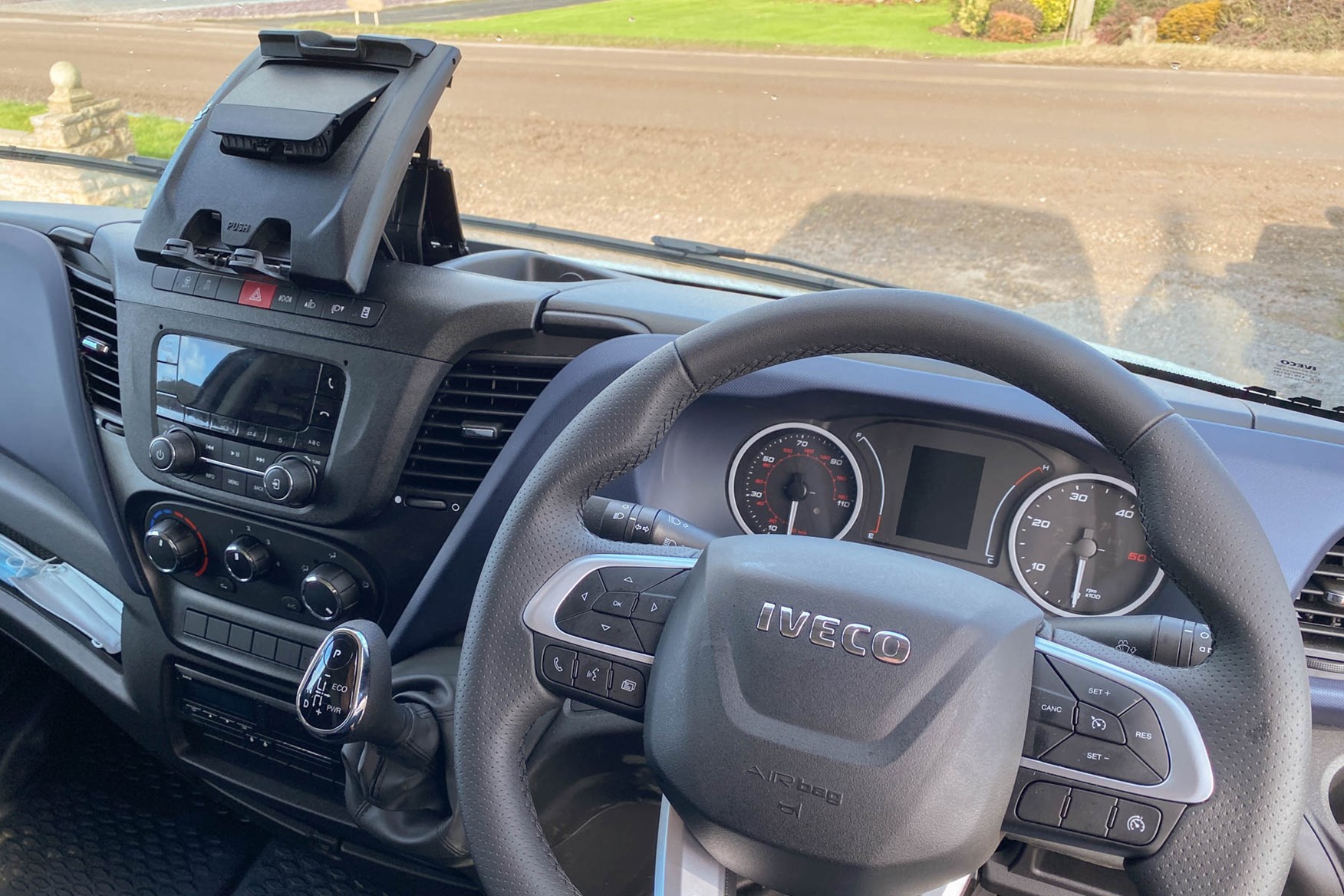
Even ignoring the City function the steering is remarkably precise and unflustered for a commercial vehicle. Never feeling remote, it nevertheless subdues most of the imperfections and disruption on the road. The flatter, truck-like wheel position is easy to feed through your hands, though the D-shaped wheel feels slightly at odds with this style of steering. Reach and tilt are adjustable, but it's never 'car-like'.
Getting a good driving position took a bit of time even for an average-height driver, though there's the usual range of adjustments plus lumbar support. Upgraded seat options – including a truck-like floating seat with suspension – may be worthwhile if you spend a lot of time in the cab.
The seat itself is a good shape, but the cushions are a little thin; if nothing else, you'll be meeting health & safety break requirements. Everything else is easy to set up, including the large mirrors – it's just the relationship between knees and pedals that takes some optimising.
The bulkhead also means there's little room for reclining the seat back, encouraging a leaned-forward driving position once again reinforcing the flat-wheel, truck-like attributes of this van.
Visibility from the cab is as good as you can expect, with large mirrors, but no driver assistance features on the Daily Business Plus to help with reversing. The A-pillars draw a straight line to the tip of the bumper, helping to judge distance at the front, but in town it can take a while before you're not always checking the mirrors for what those extended wheel arches and dual wheels are up to at the back.
Not helping visibility is the pop-up tablet holder. It positions an iPad or similar (it might grip a larger phone, but a typical one is too small) where many cars have a floating display, but the mechanism behind obscures vision to the pavement.
Given the higher-specification models come with Apple CarPlay, that would probably be a better investment; the integrated DAB radio with hands free works well enough but feels dated given the cost of the rest of the van.
Driving the Iveco Daily Business 7.0t van
Expecting the usual caveats around commercial vehicles? Sorry to disappoint – driving position aside, anyone could drive this and be comfortable with the experience.
The 3.0-litre engine is an incredibly good match for the eight-speed ZF gearbox, and barely stirs to get an unladen van underway swiftly. The gear selector is near the steering wheel, chunky and solid to use with a gated pattern rather than lock-out buttons. Swapping to manual (where you will find reassuringly effective engine braking) or between Eco and Power modes is completely intuitive, and fairly pointless when you've got a 56mph limiter.
That limiter ensures five hours of motorway driving feels akin to an aeroplane flight, with the constant note of the muted engine turning over at low revs, a pace shared with HGVs, and the gentle reminder of lane keeping if you are too slow to complete passing and the signal's gone off. There's no obvious override, so once you're committed to that elephant race you're at the mercy of the HGV you're passing finding an incline, where the ample power to weight reserves of the Iveco mean it just carries on as normal as they drop back.
Unladen, the trip computer reports 27mpg; with a full load of furniture, country roads and some city-driving that dropped to 25mpg.
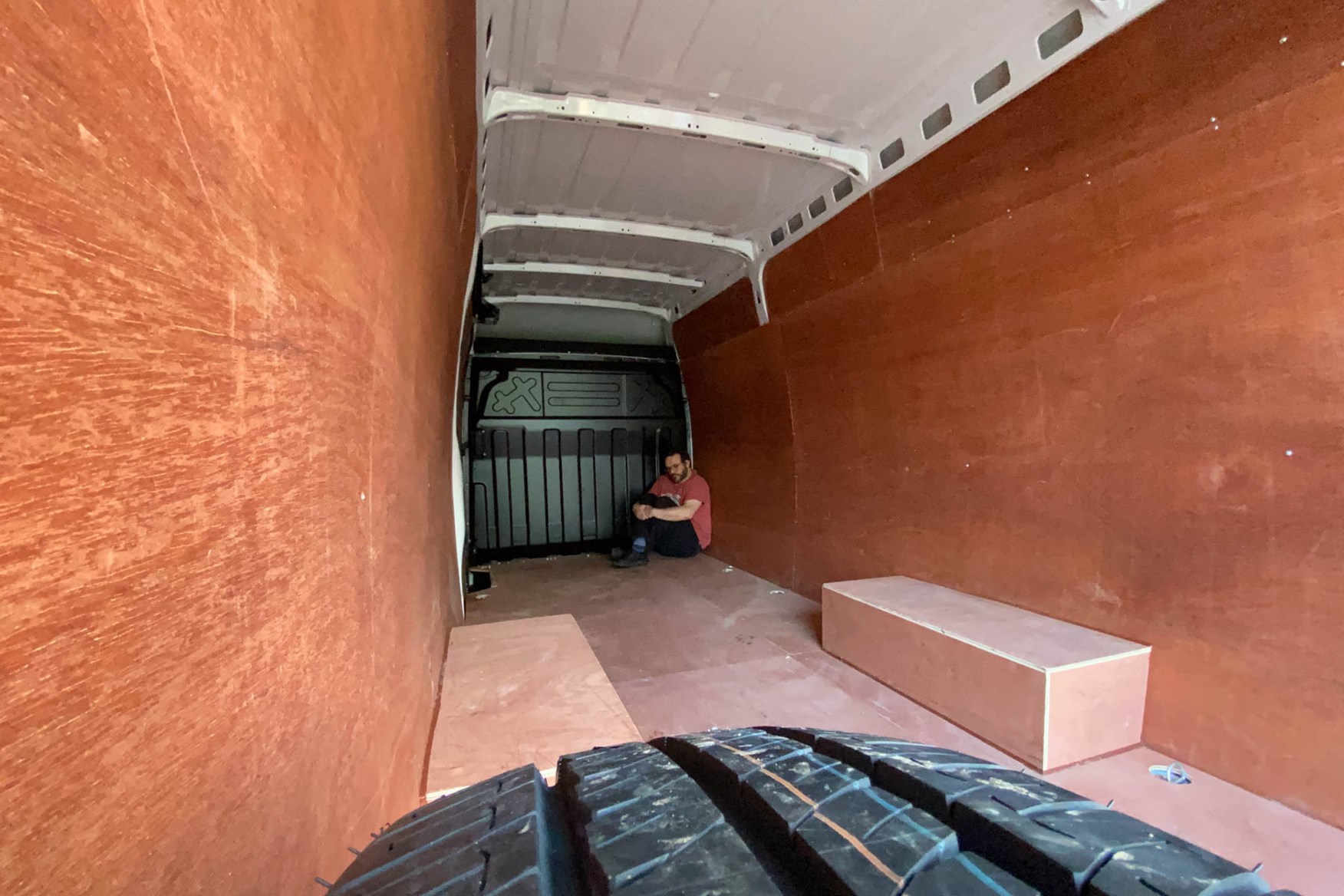
The Daily's chassis may look agricultural, but the tech isn't – so in addition to the precise steering, there are disc brakes on all four wheels. Braking is progressive and smooth – ideal for approaching roundabouts with a loaded van, it makes it easy to measure out force and control pace, as well as providing the quick, effective response needed for city-safe braking. This driver assistant is subtle, and not over-sensitive, but it does work – intervening when someone stops abruptly in the middle of turning left, but without the violence some car-based systems display.
This is reflected in the lane-keeping assistance, which is subtle yet remarkably effective. It contributes to a relaxed environment building on top of already impressive refinement; the cab is quiet despite the spartan appearance of the trim, the engine muted and gearbox smooth as you could wish for. Even the doors shut with a reasonable thud instead of a clang, though it did get a lot of condensation inside the windscreen over a foggy night – suggesting more insulation, or at least, a good absorbent chamois pad, might be needed.
Directional stability is good, but the ride inevitably reflects the strength of suspension needed for a 7.0-tonne GVW; unladen the rear behaves very well on smooth roads, but bounces noisily over imperfections. Through Edinburgh's cobbled old town, it got a proper workout. The front, remarkably, absorbed the imperfections well - no doubt thanks to the quad-tor torsion bar setup employed on heavier-duty Dailys.
Laden, it's a different story. Little bodyroll, despite the height and wheel travel available, and a smooth ride with just the occasional thump or bounce (level crossings in particular), show that this Daily needs to be working hard to be at its best.
Should I buy an Iveco Daily 7.0t
Because the license restrictions over 3.5-tonnes now affect a large group of drivers, this is only of interest if you need the capacity – but it works exceptionally well, with remarkable refinement and ease of use for such a robust design.
If you're doing a lot of drops, though, the load height can be an issue if you're on your own. There aren't that many options for a van like this, but it's sufficiently accomplished that you won't feel you're losing out over 3.5t competitors.
We'd recommend upgrading to the infotainment system in place of the DAB radio though, and the effectiveness of the lane-keeping and overall refinement suggest you'll appreciate the traffic-jam assist cruise control.


























































